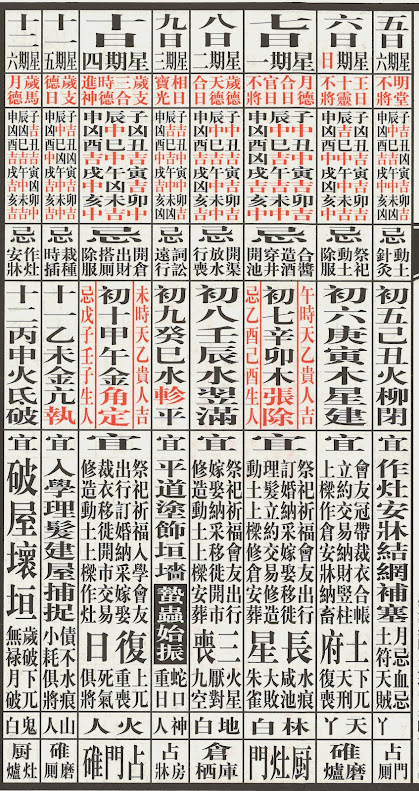Click here for the introduction to the Round and Square series "Calendars and Almanacs"
⇦⇦⇦⇦⇦ From right to left: ⇦⇦⇦⇦
2/12..............................................................................................................................................2/5
2/12..............................................................................................................................................2/5
This is one in a never-ending series—following the movements of the calendar—in Round and Square perpetuity. It is today's date in the Chinese lunar-solar (or "luni-solar" calendar; I call it the "lunar" calendar in order to distinguish it from the kinds of calendars most Westerners use. It has a basic translation and minimal interpretation.
As for interpreting the translation, unless you have been studying calendars (and Chinese culture) for many years, you will likely find yourself asking "what does that mean?" I would caution that "it" doesn't "mean" any one thing (almost any "it" you will see). There are clusters of meaning, and they require patience, reflection, careful reading, and, well, a little bit of ethnographic fieldwork. The best place to start is the introduction to "Calendars and Almanacs" on this blog. I teach a semester-long course on this topic and, trust me, it takes a little bit of time to get used to the lunar calendar. Some of the material is readily accessible; some of it is impenetrable, even after many years. And do not assume that people from China understand the traditional calendar particularly well, either. I have encountered confusion and furrowed brows for countless items in the calendar. It can seem "remote," in other words, from the world we live in these days, and yet it is printed anew every single year.
As time goes on, I will link all of the sections to lengthy background essays. This will take a while. In the meantime, take a look, read the introduction, and think about all o
f the questions that emerge from even a quick look at the calendar. You will likely find that several of the translations seem quite "fanciful" in English. I am simply trying to convey that they also sound fairly fanciful in Chinese.
Solar Calendar Date
(top to bottom, right to left)
六
日
日期星
Second Month Sixth Day
Sunday, February 6
Section Two
Beneficent Stars
Beneficent Stars
(top to bottom, right to left)
不十王
將靈日
Kingly Days
Ten Spirits
Not General
Section Three
Auspicious Hours
(top to bottom, right to left)
申辰甲
Auspicious Hours
(top to bottom, right to left)
申辰甲
凶吉凶
酉巳丑
中中吉
戌午寅
凶中吉
亥未卯
中吉吉
23:00-1:00 Inauspicious
1:00-3:00 Auspicious
3:00-5:00 Auspicious
5:00-7:00 Auspicious
7:00-9:00 Auspicious
9:00-11:00 In-Between
11:00-13:00 In-Between
13:00-15:00 Auspicious
15:00-17:00 Inauspicious
17:00-19:00 In-Between
19:00-21:00 Inauspicious
21:00-23:00 In-Between
————
Section Four
Activities to Avoid
(top-to-bottom; right to left)
忌
除動祭
除動祭
服土祀
Venerating Ancestors
Moving Soil
Discarding Clothing
————
Section Five
Cosmological Information
Cosmological Information
初
六
庚
寅
木
星
建
Sixth Day (Twelfth Lunar Month)
Cyclical Day: gengyin (27//60)
Phase (element): Wood
"Constellation Personality" Cycle: Asterism (25/28)
"Day Personality" Cycle: Establish (1/12)
"Day Personality" Cycle: Establish (1/12)
————
Section Six
Appropriate Activities
and Miscellaneous Information
(top-to-bottom; right to left)
宜
上立繪
樑約友
作交冠
倉易帶
安納裁
牀財衣
納竪合
畜柱帳
府土
復天下
喪刑兀
Appropriate Activities
Meeting Friends
Coming-of Age Ceremonies
Cutting-out Clothing (Sewing and Tailoring)
Binding Sails
Making Appointments
Trade and Commerce
Cash Payments
Erecting Pillars
Raising Beams
Granary Work
Positioning Beds
Livestock Payments
Soil Palace
Baleful Asterisms
Lower Amputee
Heavenly Punishment
Return Mourning
————
Section Seven
Inauspicious Stars
(the Chinese should be read right to left)
Inauspicious Stars
(the Chinese should be read right to left)
丫 天
Bifurcation, Heaven
————
Section Eight
Miscellaneous Items
碓
爐 磨
Pestle
Furnace, Mortar


No comments:
Post a Comment